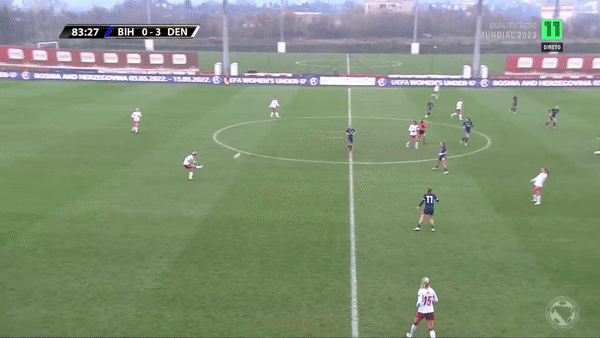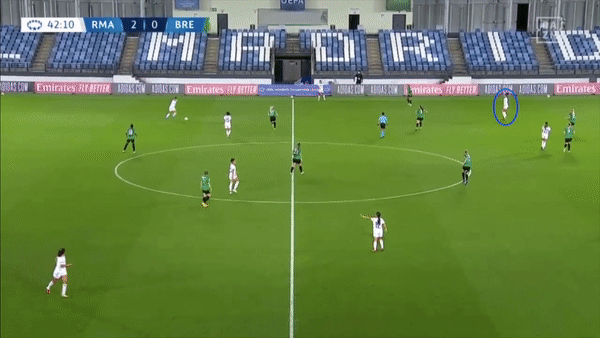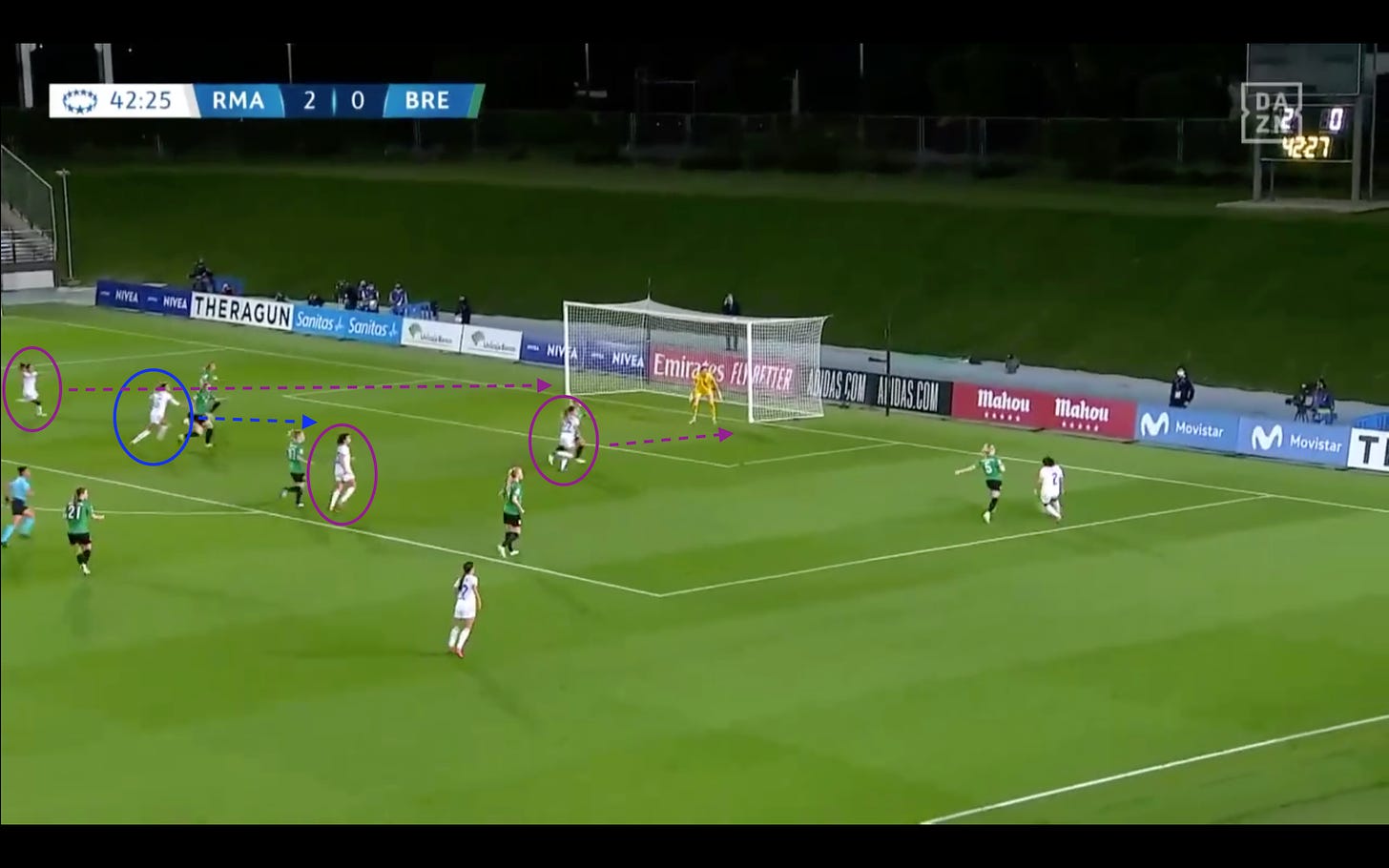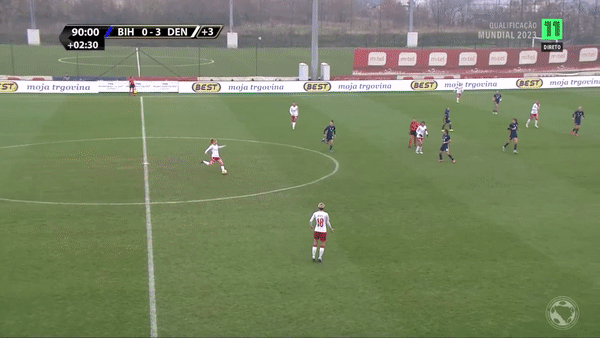INTERVIEW: Caroline Møller Hansen Analyzes Her Own Game
"I think really quickly during a match. In the first couple of minutes, I try to look at [my opponent] and be like “okay, she's fast here or this is what she does well.”'
This interview with Real Madrid player Caroline Møller Hansen was done in collaboration with Abdullah Abdullah and his ‘Pressing Questions’ series from his substack Pressing Matters.
Be sure to check out Abdullah’s other chats with Manchester United’s Maria Thorisdóttir and Sevilla’s Isabella Echeverri, and keep your eye out for more joint ventures down the road.
For the uninitiated, Caroline Møller Hansen is a 23-year-old Danish winger and forward who signed for Real Madrid in the summer. From the player’s own words (as you will soon read), her quick feet and ball carrying are the hallmarks of her game.
However, she also has a more expansive skillset, granting her positional versatility. Capable of playing up front, there’s a calculated nature to how she reads space facing both goals, aided by silky ball control when receiving to feet and chest.
Our interview with Møller comes in two parts. While both sections are tactics-focused, the second component involves video that she reacted to and analyzed in live time.
The insights Møller produced — both on her own game and the general nature of her attacking roles — are eye-opening. We hope you enjoy reading her thoughts as much as we enjoyed listening to them.
Om Arvind: In a Champions League press conference, I asked [Real Madrid coach] Alberto Toril what he thought your best position was and he said that you “can play as both a striker and a winger,” but that he saw “more possibilities for you as a left winger.”
What do you think your best role is and do your views on that change when you play with the national team? For example, you played on the left vs. Italy [in the Algarve Cup], but you were a striker off the bench in the last two World Cup qualifiers against Russia and Bosnia and Herzegovina.
My best position is as a left winger. I am really strong with both my left and right [feet], so it's not a problem to cross with my left or to shoot and finish with my right. I also feel like I am strongest when I play on the wing and have a little bit more space and time to get up to speed and do 1v1’s.
I also really like playing as a [forward] as well, because one of the things I've been working on for the past two or three years is my back-to-goal game. I feel like I've shown this more on the national team. The way I play striker here [with the national team] is better than when I play with Real Madrid. [With Denmark], I like playing as a striker, but at Madrid I like playing more on the wings and doing 1v1’s.
But I would say my strongest position is definitely the left wing. I think that's where I see my strengths — on the final line, getting the ball, and going 1v1. I also like playing the ball in small spaces with a midfielder. I like the wing — left or right, but preferably the left wing.
Om: Obviously, with the national team, it's a lot more direct. There's less of that at Real Madrid. But are your preferences also influenced by the great emphasis on building into wide areas and because the wingers play very, very wide at Madrid? Is that why you prefer playing as a winger at club level, since you can simply get on the ball more as opposed to when you play as a striker?
Yeah, Alberto [Toril] wants the wingers to stay high and wide, where, with the national team, he [coach Lars Søndergaard] wants the wing-backs to be on the last line, which makes the wingers play like an inner midfielder.
Abdullah Abdullah: Regardless of where you play, it's very clear that you have major strengths as a back-to-goal player. I just spoke to Signe Bruun before this interview and I asked her whether she sees herself and you as similar players. She said no. She thinks that when you guys start playing more, there's actually a complementary skillset there.
How does coach Lars Søndergaard seek to maximize you and do you think it’s fair to say that he sees you as an option to replicate what Bruun does on the pitch? Or do you think that you and Bruun are different enough to play together?
I actually think that we are very different kinds of players. She is 100% a target player — the classic nine. She can hold off anyone and she will convert anything in the box. I said that my back-to-goal play is something that I've been working on because I know they like this type of player on the national team. So, that's something I have had to work into my style of play. But I think my skillset is still strongest when I get to do 1v1’s and small passes in tight areas.
Also, you see how many goals Bruun scores. I obviously love scoring goals but I don't score as many as she does. I'm more the assisting type.
I'm not only saying this because she's my good friend, but I think we complement each other well on the pitch and really understand each other. I was happy that we got the chance to get some minutes together [vs. Italy] and, hopefully, in the following games, we will get to to show the coach how well we actually work together because of the connection we have.
Om: When discussing your relationship and chemistry with Bruun, are you talking about her playing you in behind, or linking up and supporting her for second balls? How do you see that playing out on the pitch when you talk about that connection?
Like the FIFA 100% chemistry. That’s Bruun and I [laughs].
She did it a couple of times yesterday in the game [vs. Italy], where she gets the ball and flicks it into space. I know her so well and I've played with her for many years. I think we just know what the other person will do before they even make a move.
Bruun also likes holding the ball up and doing short passes in small areas. I like to come and get [the ball] from her and [offer] support. And the balls [in behind] from her — even if she's turned the other way, she will find a way to flick the ball down into the area.
Om: Keeping with the chemistry theme, let’s talk about your relationship with Sofie Svava, your Real Madrid and Denmark teammate. You played with her vs. Italy and you have had some appearances with her in the past.
Can you describe your chemistry with her, how it's developed, and how it needs to develop if it hasn't developed enough?
I love playing with Sofie because she's very hard working and she's really strong in the offensive style of play. And that's why I think she matches the Spanish league and Real Madrid. Her mindset is so offensive. And I love when I have a fullback that [makes] the overlap [or goes] in behind.
I love playing with her, but I don't think we have shown it yet. With Real Madrid, we've only started one game together [at time of recording]. And, yesterday [vs. Italy], we didn't get the chance to show it so much. I think when we get to know each other, this connection with me and her will be really good and really strong, because we are both good at 1v1’s and crossing.
If we can get this partnership to work, I think it can be really dangerous both here in the national team and also for Real Madrid. We just need some time to [improve our] chemistry and train and play some more games together.
Abdullah: How much do you adjust your game based on the defenders you face? Do you seek to make certain runs or exploit certain things mentioned in the scouting report? Or do you just focus on your natural game, knowing that it’ll create advantages regardless of the opponent?
Kind of both. Of course, I always want to do the things that I know that I'm really good at. But, at the same time, I look at speed. If I play against slow players, it’s easy to just take this touch because, when you play on the wing, you have this space to take a long touch and run. But if the player is faster than me, I would rather get her to slow down through a 1v1 and then take her on, because I’m faster over the first couple of meters.
I don't do too much of looking at the scouting reports and analyzing my opponents but I think really quickly during the game. In the first couple of minutes, I try to look at [my opponent] and be like “okay, she's fast here or this is what she does well.”
Video Analysis
Om: First of all, do you think you were fouled there? Was that a penalty?
It's 1,000% a penalty. I don't know how the referee cannot see that. Look at her, she's standing right there. She’s watching everything.
Om: What goes into deciding whether you're making a run into the six-yard box or a cutback in this type of dynamic situation. Are you reading cues from the defender? Are you seeing where your teammate is carrying the ball and where it looks like they'll cross it? And you also seem to fake like you're going straight before exploding off sideways to get to the cutback. Was that a deliberate move to create separation?
I actually think that I was going to go to the first post, that's why I'm [originally] running straight. But then I see her [Sarah Katrine Thygesen’s] touch is a little bit long and number four [Ana Bojanić] is going to close down the pass to the first post, so that's why I [make this move] to get to the cutback.
Normally the first run is always to the first post, so that's why my mindset was to go there, but I see that her [Thygesen’s] touch is weird and she's not going to be able to hit it first post, so that's why I tried to do this little “drop out," which we have trained many times with the national team for cutbacks.
Om: I'm sure this one is seared into your memory. This is the hat-trick goal. Take us through the sequence. Again, I have that question about the run where you start on the outside of the defender before dipping back inside. If you can take me through your thought process in regard to that, specifically, that would be great.
When I received the ball, I actually think I wanted to open up and go straight, but I kind of had a bad touch. So the midfielder comes down to cover. After that, I just wanted to keep possession. So I turn back and find Claudia [Florentino] and she does a great job of switching the point of attack because Kenti [Robles] is alone 1v1. Lorena [Navarro] shows well and plays the one-two.
I think we do a good job of covering all spaces in the box; we have one [going to the] first [post] and one [going to the] second [post] and then my position is [aimed at] the penalty spot.
I see I have a player on me. So, I try to do a quick feint to get her to move a little bit back. I make this quick movement and she's one step behind, giving me the time to get in front.
It's easy with these kind of crosses — you just have to hit the target and it will basically always be a goal.
I love when I play with Kenti because she is looking for me and I know I just need to get in front of the defender and she will find me. She’s basically assisted all of my goals at Real Madrid.
So yeah, very, very thankful for this one. It was a perfect way to finish the hat-trick.
Om: Happy news for you that Kenti has renewed. She's with the team for at least a couple more years.
Exactly.
Om: So, this is really interesting because back-to-back we're seeing two different types of movement. The first one was extremely reactive and this one was more predetermined. We can do all the analysis we want, but, in these moments, I feel like players are the only ones who can give us actual insight into these things, because it's happening so fast. How do we know what's intentional and what’s not?
Abdullah: What’s your thought process behind this and what are you trying to do when you get the ball in such a deep position and turn?
As I mentioned earlier, the type of number nine the national team wants is a strong player that can hold up play and lay it off. Here, I come down and get the ball. I see Sofie (Junge-Pederson) open, so I lay it off to her and then continue my run. I had just come in [with ten minutes left] and wanted to show off as much as possible.
I tried to switch the point of attack because I think [Russia had] lost possession on our right flank. So all the Russian players were over on that side. Sofie (Svava) is basically alone 1v1. It's a bad pass, I can see that, but if the ball gets out to her, she will be in a 1v1 situation.
Om: Do you like this structure for the second ball? Because the chest pass — I don't know if you were trying to play it harder — but it seems like it runs on a little bit. Are you okay with this or do you want much tighter connections when you're receiving in these types of spaces?
I always want a midfielder to be in support and, here, it would obviously be ideal if Junge was a little bit closer to me, but when the Russian players are not so tight to her, it's fine. I see her and I just want to lay it off in one touch because I have strong pressure on my back.
And then I just continue my run. Junge sees it and it's good to try to keep the momentum and play it forward because the two attackers — I don't know if it's Stine Larson or who was playing over there — are running forward. We want to play this attack forward and not just turn back. You can see from the body positions of all our players that we want to go forward.
Oh, yeah. I remember this.
Abdullah: After you try to receive the long ball and you've turned to make your run, what spaces are you targeting? Do you prefer to attack the channels or do you prefer going centrally?
I kind of like both, but I see that the channel in the midfield is closed and that there is a huge space behind the Russian right back. I know Svava’s strong foot is her left, so she will easily play the pass to me.
And I think one of the things that the the coach is missing in the national team is [the ability] to make these runs [into depth] to create space for others. The players I am playing up top with [in this scenario] are Stine Larson and Mille Gejl, who are not the type of players who make these [runs into depth]. I am more that type of player.
Also, when I play with with Bruun, it’s the same. She hardly ever does these runs. In my mind, I [am aware] that the coach wants me to make these runs.
That's why I’ve come [into this game] with a lot of energy. It's the the 91st minute, so I just want to go into a full sprint to try to create space. I end up getting the ball and I manage to come out of a tough 1v2.
Om: Yeah, you get to show off your dribbling skills.
Abdullah: You know there's this new stat called nutmegs per ninety. You might be in the top ten for that if you keep this up.
[Laughs]
Om: I want to ask you about your general thought processes when you're receiving between the lines, especially to feet. In this one, you're receiving the ball in a crowd of players and have to adjust to two different types of deliveries while keeping the ball secure and firing the quick return pass.
In your opinion, what does it take to be effective in these types of situations, when you have basically no time to react or think about things and you can't always see what's behind you?
I think the most important thing in these situations is actually the [direction of the] pass. I can see the pressure coming on my right side. If the [first] pass was on my left, I would have been able to turn up the pitch. It's these small details and centimeters that count in these situations. It’s the pass that's going to determine whether the attacker will be able to turn or just lay it off.
So that's why I chose to play backwards because I'm surrounded by, what, three players?
And, like I said, the coach really wants the attacking players to hold the ball and not lose possession, especially in these situations when I drop down to get it.
The second time I receive, I just want to move the play out wide and then I end up kind of standing behind our midfield.












